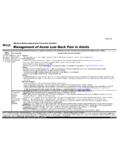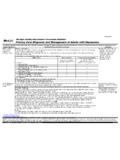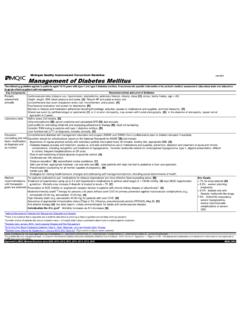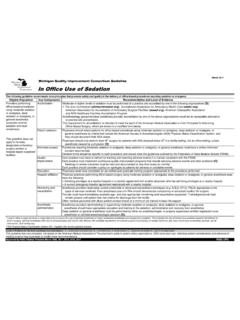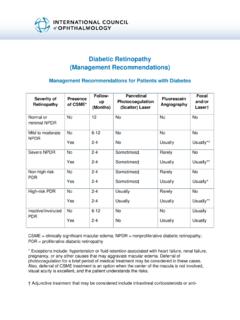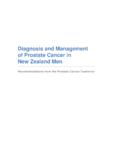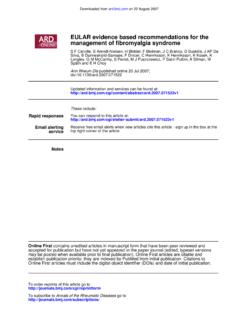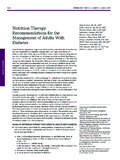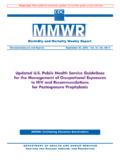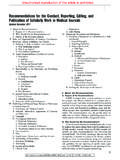Transcription of Michigan Quality Improvement Consortium …
1 August 2017 Eligible PopulationKey ComponentsInitial assessmentPatient education and nonpharmacologic interventionsGoals of TherapyPharmacologic interventionsMonitoring and adjustment of therapy [D] Michigan Quality Improvement Consortium GuidelineMedical Management of Adults with HypertensionThe following guideline recommends diagnostic evaluation, education and pharmacologic treatment that support effective patient and Level of EvidenceHypertension, Stage 1: initiate therapy and recheck within two months until goal is , Stage 2: initiate therapy and recheck weekly or more often if indicated. Symptomatic Stage 2 may require hospital monitoring and at each visit.
2 If elevated, measure BP seated 5-10 minutes, feet flat, arm at rest, appropriate size cuff. Check serum potassium and creatinine at least annually for patients on diuretics/ACE- patients > 18 years of based on 2 or more seated BP readings on each of 2 or more office :Stage 1140-159/90-99 mm HgStage 2>160/>100 mm HgApproved by MQIC Medical Directors August 2009, 2011, 2013, 2015, 2017 This guideline represents core management steps. It is based on James, PA, Oparil S, Carter, BL, et al. 2014 Evidence-Based Guideline for the Management of High Blood Pressure in Adults: Report From the Panel Members Appointed to the Eighth Joint National Committee (JNC 8).
3 JAMA. 2014:311(5):507-520. ; and Kidney Disease: Improving Global Outcomes (KDIGO) CKD Work Group. KDIGO 2012 Clinical Practice Guideline for the Evaluation and Management of Chronic Kidney Disease . Individual patient considerations and advances in medical science may supersede or modify these modification: weight reduction (BMI goal < 25), reduction of dietary sodium to less than gm/day, DASH diet [A] ( diet high in fruits and vegetables, reduced saturated and total fat), aerobic physical activity > 30 minutes most days of the week, tobacco avoidance, increased dietary potassium and calcium, moderation of alcohol consumption2 [A].
4 Consider self BP monitoring. Check accuracy of home measurement device regularly. Home readings are often 5 mm Hg lower than no other risk factors and < 60 years of age: target BP <140/90 [A]. If no other risk factors and 60 years: target BP <150/90 [B]. Patients with risk factors, including diabetes: target BP <140/90 [B]. Consider target BP <130/80 for CKD patients with albuminuria [D]. Caution: low diastolic or orthostatic symptoms may limit ability to control systolic. Use extreme caution if diastolic is below 60. For diabetics, mortality increases if diastolic is below , Stage 1 based on systolic and/or diastolic (140-159/90-99): start with thiazide-type diuretic, ACE-I, ARB, or DHP-CCB3 for almost all patients [A].
5 Hypertension, Stage 2 ( 160/ 100): consider two-drug combination (thiazide plus ACE-I or DHP-CCB).In general, diuretics and DHP-CCB appear to be more effective as an initial treatment in recommended in patients with diabetes, CKD, or heart failure. [A]Beta-blockers are recommended in patients with ischemic heart disease or heart treatment until treatment goals are met; 3 or more drugs may be necessary for some patients to achieve goal BP. Caution: NSAIDs may complicate management of hypertension and worsen renal concurrent use of ACE and of Evidence for the most significant recommendations: A = randomized controlled trials; B = controlled trials, no randomization; C = observational studies.
6 D = opinion of expert panelThe objectives of the initial evaluation are to assess lifestyle, cardiovascular risk factors, concomitant disorders, reveal identifiable causes of hypertension and check for target organ damage and cardiovascular examination: 2 or more BP measurements1 on initial visit plus one or more follow-up visits using regularly calibrated equipment with the appropriate sized cuff and separated by at least 2 minutes with the patient seated and standing, verification in contralateral arm, funduscopic exam, neck exam (bruits), heart and lung exam, abdominal exam for bruits or aortic aneurysm, extremity pulses and neurological assessment [D].
7 1 American Medical Association. Essential Guide to Hypertension: Accurate Blood Pressure Readings ( ) 2 Moderate alcohol consumption is generally defined as up to two drinks per day for men, one drink per day for = angiotensin converting enzyme inhibitor, ARB = angiotensin receptor blocker, DHP-CCB = long-acting dihydropyridine calcium channel blocker ( amlodipine, felodipine)
